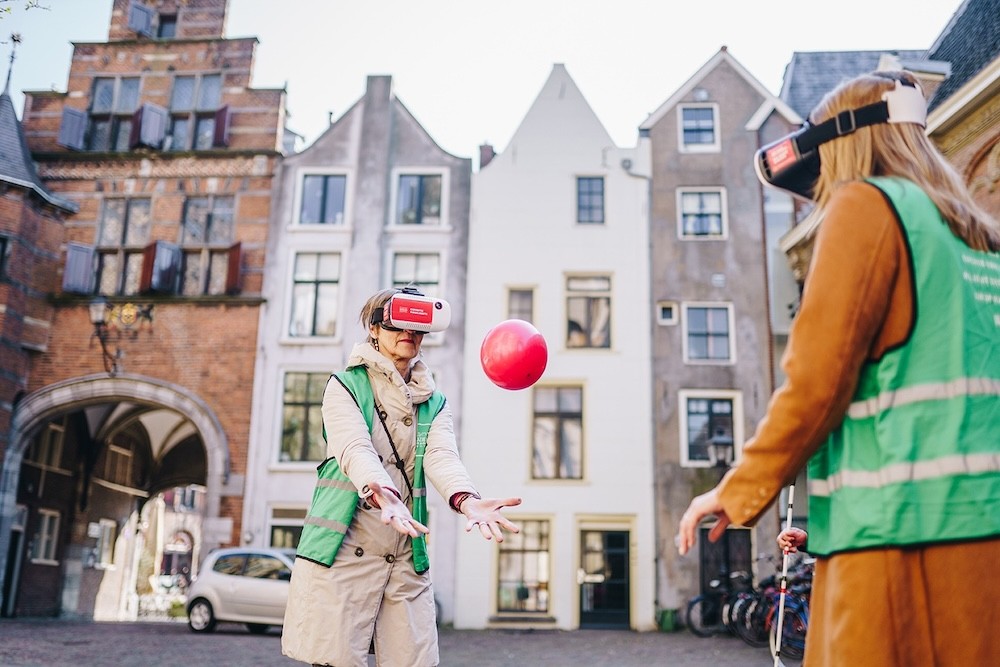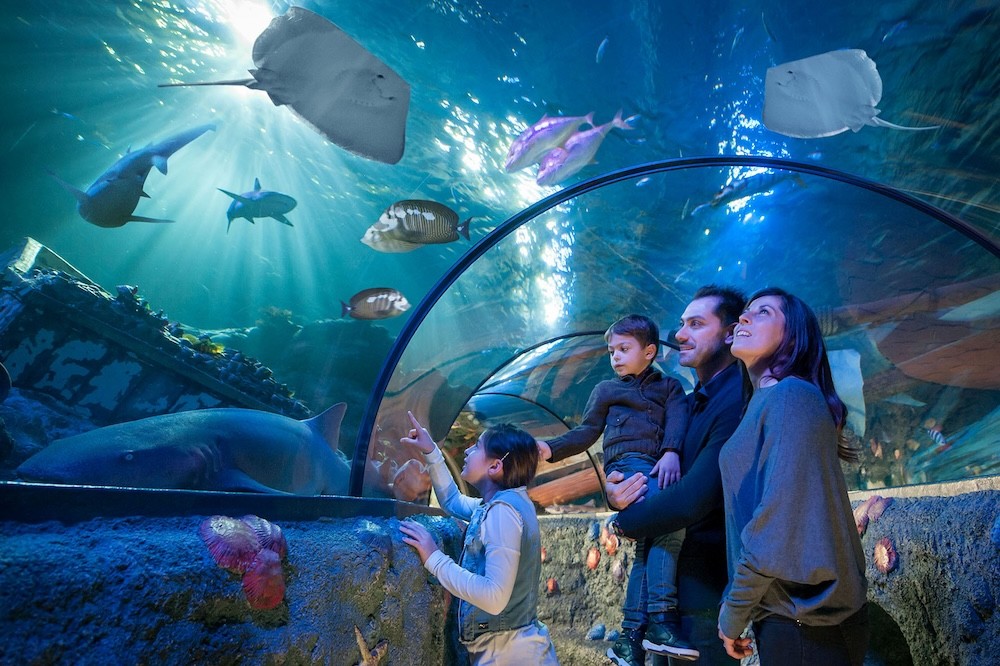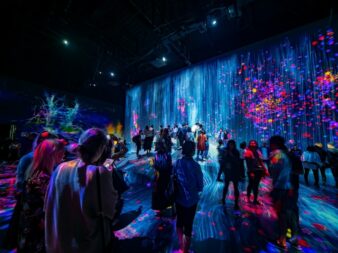There’s an old-fashioned notion that visiting a museum means patiently walking around and reading information from plaques. However, with the rise of interactive exhibits, museum visits have evolved into dynamic experiences where visitors can actively engage with the displays. Participating in a tour is about sitting on a bus while someone makes announcements. And while visiting an attraction like an amusement park or a zoo might feel more engaging, it’s still more or less a passive experience. Right?
That myth of passivity is being challenged by a new wave of highly engaging interactive tourism experiences. Today, museum visitors, attraction participants, and tour-takers are all engaging with subject matter in ways that challenge outdated perceptions. They’re being invited to learn and be entertained by engaging with art, history, culture, and science.
Interactive merely means that the visitor plays some part in the experience. This could be a low-stakes action like pressing a button to hear a recording or handling a starfish at an aquarium. But interactivity has dramatically increased in sophistication. The best museums, attractions, and tours now use a range of technologies – infused with bold creativity – to cultivate memorable experiences for their audiences.
If you aren’t yet focused on creating interactive exhibits and environments, or could use some inspiration and new ideas, read on.
What is an interactive exhibit?

Interactive exhibits invite the visitor to take action in order to have an experience. This includes things as simple as swiping through a visual display on a touchscreen or using a joystick to control a player. But interactivity can also be far more creative and consuming than these simple gestures. Ultimately, interactive museums and tour operators that employ engaging techniques invite visitors to participate in their experience.
MUSE, a science museum in Trento, Italy, takes visitors on a journey from a tropical greenhouse to an entire floor rich in the history of primitive mankind. But it’s the top floor of the building that most excites young visitors – that’s where the interactive science exhibits are found. One section of this floor, playfully called Maxi Ooh!, attracts the youngest visitors (under five) to get their hands on the world of nature and science.
Child-focused museums have always focused on interaction as a way to engage and motivate young minds. But even the most grown-up of grownups tend to participate more deeply, concentrate for longer, and understand new ideas and information more clearly when invited to interact with a museum exhibit.
Interactive technologies to enhance museums and tours

When it comes to learning, tapping into people’s natural curiosity is an effective mechanism, and study after study has shown that people learn better by doing than by simple observation. Interactivity taps into multiple learning styles to appeal to a diverse range of guests.
But museums are not just about learning. They’re also about entertainment, self-growth, and social opportunities. Interactive exhibits can help to break down the seriousness of the museum experience, ultimately creating a more friendly, welcoming environment.
It’s worth noting that interactivity is not just for museums. Other kinds of attractions and even tours can tap into the power of interactive exhibits. A recent report on immersive film tourism by the industry publication Arival describes how big brands use interactive experiences to place visitors inside the movies they love, with events like Bond for a Day and Stranger Things: The Experience. Fans get to embody their favorite characters within immersive environments and embrace their alter egos.
Technology is an important tool

As just one type of interactive experience, immersion is nothing new in the world of tourism. By its very nature, any historical reenactment is immersive. When you visit Old Sturbridge Village in Massachusetts, you enter a 19th-century American town with over 40 preserved buildings, working farms and trade shops, and actors role-playing their parts. To the visitor, the experience is like stepping back in time.
But “immersive experiences” have taken on a new layer of meaning in the last decade. Thanks to technologies like virtual reality (VR) and augmented reality (AR), immersive experiences have increased in popularity, often placing the visitor into another world entirely. Led by experiences such as Immersive Van Gogh and Frameless: London’s Immersive Art Experience, immersive technologies have become an incredibly popular tool for museums and events that aim to make their exhibits and experiences both more interactive and memorable.
Casa Batlló example
At Casa Batlló in Barcelona, visitors can “journey into the genius of Gaudí” with all five of their senses. In the Gaudí Dôme, an immersive experience featuring more than 1,000 screens, multiple projectors, and state-of-the-art sound, invites the visitor to lose themselves in the genius of the famous Catalan architect and experience firsthand how nature informed his work.
In other parts of the interactive museum, still imagery on the walls comes to life as visitors approach, thanks to micro-motion sensors hidden within the pictures. Advanced machine learning and modern AI have been put to use deciphering the patterns and biomimetic structures within Gaudí’s work, revealing his impeccable design logic and describing it to museum visitors in clear language. Visitors are invited to use tablets installed with AR content to go back a century in time and see spaces the way Gaudí once did.
Today, plenty of museums and venues employ AR to create a more interactive visitor experience. The Asian Art Museum in San Francisco places visitors inside of the artworks as they wander through large empty rooms rendered into a multisensory dreamscape by VR. Walt Disney World celebrated its 50th anniversary in partnership with Snapchat, inviting young visitors to virtually interact with characters from its archives and post their own content to social media.
Immersive technologies lend themselves to creating interactive experiences for visitors, but there are plenty of other types of technology that can also be used in this arena. Motion sensors, touchscreens, and innovative apps are building blocks of an unlimited number of future interactive experiences.
(But it’s just a tool)

Technology is more and more important to creating engaging interactive tourist experiences, but ultimately, it’s just a tool, and not the only one.
Recently, artist Tomas Saraceno installed an exhibit called Cloud Cities Barcelona at the top of the famous cylindrical building Torre Glòries. The installation, built of simple physical mirrored facets and cable, invites visitors to walk around and see the city reflected in countless ways through the viewing gallery known as the Mirador Torre Glòries.
Cloud Cities is an elegant example of how a museum or attraction can create engaging, interactive experiences for visitors without involving computer technology at all. In fact, the most important element of interactive tourist experiences is not technology, but storytelling.
How to tell a good story with your interactive exhibit

What kind of story is your museum invested in telling? Do you have a unique or compelling angle on a historical subject or an area of art or science? No matter the technology you choose to use (or not), interactive exhibits should come from a place of intention, not just flash.
Here are five best practices for creating interactive experiences:
1. Create a unique, compelling experience

At muZIEum in the Netherlands, a current exhibit uses immersive technology to invite seeing visitors to experience what it’s like to be blind. This is not a simple “close-your-eyes-and-use-your-imagination” type of event. Visitors don VR glasses that simulate blindness and are led on a daring adventure that gives the sight-abled insight (so to speak) about how blind people must rely on their other senses to experience the world.
Ideally, your interactive exhibit gives visitors an opportunity to have an experience they couldn’t have anywhere else.
2. Invite creativity

At Gardaland SEA LIFE Aquarium, Italy, the Interactive Ocean room invites visitors to design a fish from their imagination and bring it to life in a “magical 3D aquarium.”
Children are naturally curious and creative. So, for that matter, are most adults, whether they’re typically given a chance to express it or not. Let your interactive exhibit be an opportunity to invite creativity and originality from participants of all ages.
3. Gamify it

Nothing motivates a visitor more than a challenge. London’s National Gallery recently launched an AR app with a children’s game called The Keeper of Paintings and the Palette of Perception. Through this app, children are invited to find clues, collect gems within the paintings, and solve puzzles as they navigate their way through the museum.
Gamification can take a lot of different forms, from a simple custom app to escape rooms and the use of motion sensors.
4. Use a multisensory approach

“Don’t touch the exhibit!” is a stern warning common in museum environments. But with interactive exhibits, visitors are often invited to do just that, as well as listen, play with, and smell.
In 2021, the Mauritshuis Museum partnered with IFF (International Flavors and Fragrances) to create a “fragrance box” that fans at home could order to accompany a 30-minute digital tour of 17th-century art. The scents, “winter perfume,” “foul-smelling canal,” “grocer’s shop,” and “Dutch bleach fields,” inspire the imagination with their names alone.
All five senses can be activated with an interactive museum experience. Keep this in mind within your own design.
5. Make it inclusive

And finally, one of the most compelling reasons to build out interactive experiences is to make them engaging and accessible to people of all kinds, regardless of their age, level of education, cultural background, mobility, and the ways in which they learn. Considering that 15% of the population is neurodiverse, finding inspired ways to invite and include this population alone will serve your museum well.
At the Van Gogh Museum in the Netherlands, a touchable scale model of the museum allows blind visitors to literally feel their way around the building in advance.
For more on designing accessible interactive experiences, the Smithsonian Museums have published extensive research and best practices into this subject, which you can read here.
And for further inspiration from the winners of the 2023 Remarkable Venue Awards, many of whom are doing innovative things with interactivity and technology, meet our global winners.



